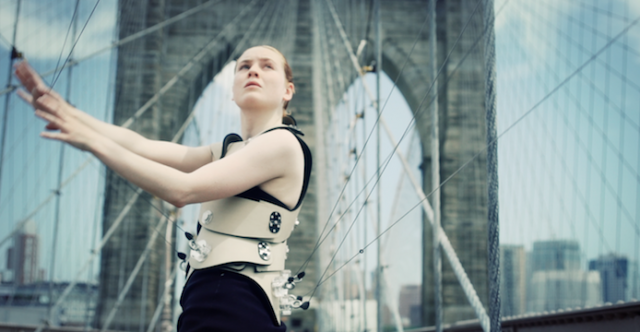
The Human Harp, a global multi-media project founded by Di Mainstone, explores the idea of attaching controls to suspension cables, making it possible to ‘play’ a bridge as an electro-acoustic instrument.
Here’s an example, recorded at Bristol’s Clifton Suspension Bridge:
Here’s the Human Harp recording at the Brooklyn Bridge:
 Human Harp is based on a small collection of devices that clip onto suspension bridges:
Human Harp is based on a small collection of devices that clip onto suspension bridges:
- Bridge-Bow Device that will cause the hanger to vibrate by being struck by rubber balls. The striking action is caused by the ‘Movician’ pulling on a retractable string housed in a pulley built from a modified dog lead.
- The Digi-Bow controls the sound generated by the hanger it is attached to. The sound generated by the Bridge-Bow is captured by the contact microphone connected to the Digi-Bow. This audio is passed on to the Hub. The Digi-Bow contains a Pulley constructed from a modified dog lead as used in the Bridge-Bow. The length of string extracted from the pulley is captured by a rotary encoder and the angle that the string is extracted is captured by a gyroscope. This circuitry is largely contained to the Tech Dome attached to one side of the pulley and protected by a 3D printed dome. The Digi-Bow is attached to the hanger with a rubber Hang-On and carabiner. It receives power from the Hub and sends the Hub the data the string generates along with the audio from the contact microphone.
- The Hub houses the computer processing the audio captured by the contact mic and the control data generated by the Digi-Bow.
- Harp-Hoist – A modified extendable pole with a 3D printed Harp-Hook at the end, to allow easy installation of the the parts of the Human Harp that are attached to the hanger without needing heavy-equipment such as scissor lifts.
- Harp-Harness – A garment worn by Movicians during a performance. It contains a number of integrated pieces of hardware that let the Movician easily attach multiple strings to their body.
Details are available at the project site.

Pretty cool concept and sounds, I’d love to see more
I bet they get fed up with people telling them to “Take it to the bridge”
wow. just great. wonderful idea. wonderful sounds. wonderful video. inspiring to watch.
To get the most out of the Human Harp you’re going to need a bridge – and I just happen to have one! If anyone is interested in owning the Brooklyn Bridge I’ll let it go cheap. Not only will you be able to strap in on and make music, you can also add toll booths to make a few extra bucks off the traffic. I own the choicest cuts of NYC so if you’re interested in purchasing Madison Square Gardens or The Statue of Liberty, let me know.
Does your bridge have ilok protection? If so,no sale.
I’m not familiar with Di Mainstone, but I’m happy to see another woman involved in experimental music.
Interesting concept, and some interesting sounds. I’m struck by how slickly engineered all of those devices appear to be – I’m thinking that Human Harp is not a poor-person’s instrument.
My only criticism is that, given what must be a rather amazing amount of time, thought, effort, and money that has gone into this, the “suit” worn by the “Movician” is rather unattractive in an in-your-face kind of way: it looks like some kind of awkward prosthetic / medical therapy device. I’d think they’d put some effort into making it look better. Given that these people are running around on bridge roadways, flashing lights and dayglo colors might really be worth investigating.
In the good old days this would be called industrial music.
Please don’t get me wrong. I like the concept but an artist dressed in a dada inspired white garment fooling around with a metal structure had sound better before… in the 20th century.